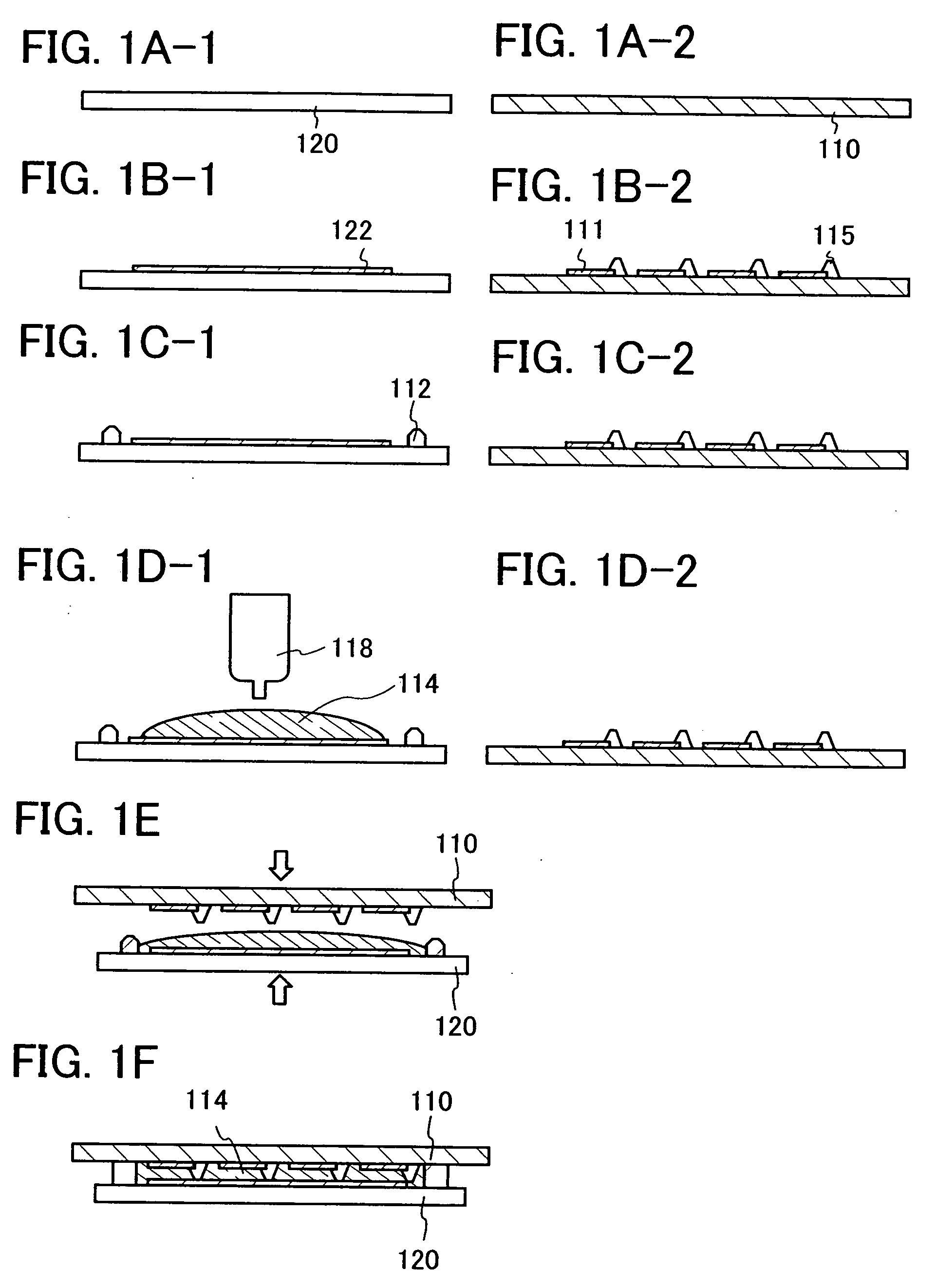Method for manufacturing liquid crystal display device
a liquid crystal display and liquid crystal technology, applied in the field of liquid crystal display devices, can solve the problems of static electricity generation and dust generation, destruction of a switching element formed over a substrate, and difficulty in uniform irradiation of light energy with respect to a substrate surface, etc., to achieve high contrast, wide viewing angle, and high quality black display
- Summary
- Abstract
- Description
- Claims
- Application Information
AI Technical Summary
Benefits of technology
Problems solved by technology
Method used
Image
Examples
experiment 1
(Experiment 1)
[0060]FIGS. 3A to 3D show a manufacturing process for an evaluation liquid crystal element. First, a spherical spacer (a bead spacer with a diameter of 1.9 μm) was sprayed using a spray nozzle 501 over a first substrate 500 which was provided with a transparent electrode (ITO) as shown in FIG. 3A. Next, a mixture 504 of VA mode liquid crystal (MLC 2038) in which octadecyltrimethoxysilane (hereinafter referred to as ODS) of 10 wt % was dispersed was dropped from a dropping nozzle 503 to a surface of a second substrate 502 which was provided with a transparent electrode (ITO), as shown FIG. 3B. Then, the first substrate and the second substrate were attached to each other as shown in FIG. 3C. At that time, a gap between the pair of substrates was maintained with the spherical spacer. A liquid crystal element 507 manufactured as described above and shown in FIG. 3D was an evaluation element. The structure of the evaluation liquid crystal element manufactured as described ...
embodiment mode 2
[0063] Here, explained is an example of performing seal drawing on a first substrate side and injecting liquid crystal after attaching a pair of substrates to each other. The flow of panel manufacturing is explained below.
[0064] First, a second substrate 220 serving as an opposite substrate and a first substrate 210 provided with TFTs (not shown) in advance are prepared as shown in FIG. 5A-1 and FIG. 5A-2. Note that an opposite electrode 222 made of a transparent conductive film is formed over the second substrate 220, and a pixel electrode 211 made of a transparent conductive film is formed over the first substrate 210 in advance.
[0065] Next, a spherical spacer 215 is sprayed over the second substrate 220, and a sealant 212 is drawn over the first substrate 210 as shown in FIG. 5B-1 and FIG. 5B-2. Although the sealant 212 is arranged so as to surround a display region, the sealant 212 is not arranged in a portion later serving as an inlet (not shown here) for injecting liquid cry...
experiment 2
(Experiment 2)
[0075] A pair of substrates each provided with a transparent electrode (ITO) was attached to each other using a thermosetting seal. In addition, a bead spacer with a diameter of 1.9 μm was dispersed in the seal to maintain a distance between the substrates, which was used as an evaluation element.
[0076] After that, liquid crystal in which ODS of 0 wt % to 10 wt % was dispersed was injected between the pair of substrates and heated at 130° C. for one hour, thereby performing realignment treatment. ODS dispersed in liquid crystal adsorbs to an interface of ITO or a substrate after the injection and forms a self-assembled monolayer. The structure of the evaluation liquid crystal element manufactured as described above is similar to that in FIGS. 2A and 2B.
[0077] The evaluation liquid crystal element manufactured as described above was evaluated under similar conditions to those of Experiment 1 by the system of measurement shown in FIG. 4. A result of transmitted light l...
PUM
| Property | Measurement | Unit |
|---|---|---|
| size | aaaaa | aaaaa |
| size | aaaaa | aaaaa |
| size | aaaaa | aaaaa |
Abstract
Description
Claims
Application Information
 Login to View More
Login to View More - R&D
- Intellectual Property
- Life Sciences
- Materials
- Tech Scout
- Unparalleled Data Quality
- Higher Quality Content
- 60% Fewer Hallucinations
Browse by: Latest US Patents, China's latest patents, Technical Efficacy Thesaurus, Application Domain, Technology Topic, Popular Technical Reports.
© 2025 PatSnap. All rights reserved.Legal|Privacy policy|Modern Slavery Act Transparency Statement|Sitemap|About US| Contact US: help@patsnap.com



